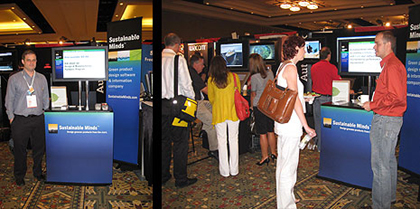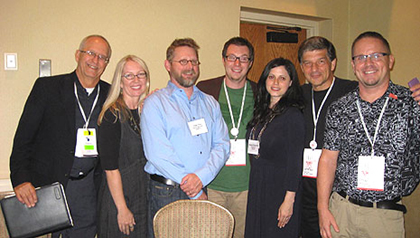


Left: GREG CANAVERA, SM’s Director of Software Design manning the demo station. Right: DANE WESENBERG, our ASU intern, spreading the word about SM.
Our first trade show!
This was a very special event for us in many ways. We announced the big news about our strategic relationship with Autodesk [1], who made it possible for us to be at the show by providing a demo station in their booth. We are truly honored to have this special relationship with Autodesk, the only design and engineering software company out there actively building tools that enable their customers to design greener buildings and products.
I wrote in my first post, Part 2: The genesis of Sustainable Minds ― Things happen in threes [2], about the events that inspired me to start this company. This was one:
“In November, 2006, while attending the U.S. Green Building Council’s national GreenBuild conference, Autodesk announced its partnership with the USGBC to integrate LEED into their product, Revit® Architecture. I thought it was brilliant to integrate new knowledge with the software tools professionals are already using.”
That said, it was a profound experience for me to be at the IDSA national conference just shy of two years later, effectively working to accomplish a similar result for people who design and make products.
The results: We had great conversations with people from design firms, manufacturing companies and colleges and universities and were gratified to get the feedback that people are excited about, and looking forward to using our software. Watch for our beta release later this quarter!
Panel session: “Sustaining Sustainable Design: How can we do it?”

Panelists from left: WILLIAM BULLOCK, professor and chair, Industrial Design Department, University of Illinois-Urbana/Champaign; ERIC BENSON, asst. professor of graphic design; University of Illinois-Urbana/Champaign; PETER FINE, asst. professor of graphic design, New Mexico State U.; JOHNPAUL KUSZ, associate director, Center for Sustainable Enterprise, IIT; MELANIE WIESENTHAL, design director, Martha Stewart OminiMedia; PHILIP WHITE, asst. professor, Industrial Design Department, Arizona State U. and chair, IDSA Ecodesign Section; DION Zuess, creative director, EcoLingo
I attended several conference sessions, the most on-topic was this one. An excerpt from the description in the program read:
“… the notion of sustainable design is finally receiving the attention it deserves. Despite the attention, the movement still lacks universal acceptance, a scientific metric to gauge success and, most importantly, a functioning system of reclamation and capture for it to work as conceived. In order to sustain sustainable design, we must first determine a universally accepted definition of what it is currently and also what it will need to be in the future. We must then ask ourselves, what can professional designers do to help build and sustain this current sustainable design momentum? What are our new challenges as leaders in this burgeoning field? Besides product and graphic designers, will the immensity of sustainability force us to be the champions of better systems design? Are we ready to make a collective effort in tackling this problem? And finally, how do we prepare your current and future designers to be ready for future environmental and societal issues? The panel will address these and other important issues including sustainable design education, assessment strategies and tools, and the need for a sustainable design aesthetic.”
This was quite an ambitious agenda for a one-hour panel with seven participants! It started with each panelist telling a bit about themselves, and how they acquired the sustainable design knowledge to be doing what they’re doing. This was interesting, as I like hearing people’s stories about the arc of their career. Following this was some structured Q&A, and then the moderator, Eric Benson*, posed the question: “What’s stopping us from designing greener products?”
The ensuing discussion was indicative of the problem. There’s no common language for, and no agreement on what are the most important problems to be addressing, and then how to take action. Because the panel was made up of graphic and industrial designers, the responses ranged from tactical ideas to broader questions regarding each type of design. One audience member passionately held a mini-discussion on why graphic designers shouldn’t worry about specifying recycled paper, or using less toxic inks – neither of those things will have as much impact as using their design skills to communicate messages about sustainability.
The simple answer to Eric’s question was actually contained in the session description. For designers and manufacturers to make greener products, they need:
And that’s why we started Sustainable Minds.
-------------------
*Check out Eric Benson’s site renourish [3], a resource for the graphic design industry. “At renourish, we're helping to start the conversation on green graphic design by providing definitions, tips, and links to sustainable resources designers can use to make their work a little greener.”
Links:
[1] http://biz.yahoo.com/prnews/080911/aqth041.html?.v=69
[2] http://www.sustainableminds.com/blog/part-2-genesis-sustainable-minds-―-things-happen-threes
[3] http://www.re-nourish.com